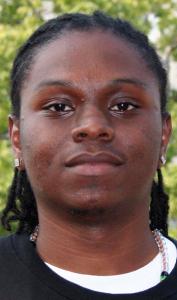Glaucoma is the second leading cause of blindness in the United States. Sometimes called the silent thief of sight, glaucoma can damage your vision so gradually that you may not notice any loss of sight until the disease is at an advanced stage.
Ralph Hazlewood, a Dean’s Graduate Research Fellow at the University of Iowa, researches glaucoma. In his work as a Ph.D. candidate in the Genetics Interdisciplinary Graduate Program, Hazlewood identifies and characterizes the genes that cause glaucoma and similar diseases. He works with colleagues in Associate Professor John Fingert’s laboratory in the Department of Ophthalmology and Visual Sciences.
The chief feature of glaucoma is a progressive degeneration of the optic nerve, which carries the visual signal from the eye to the brain. According to Hazlewood, a similar eye disease known as cavitary optic disc anomalies (CODA) may hold keys to understanding glaucoma. As a result, Hazlewood and his colleagues in the Fingert lab are studying CODA as a model of the optic nerve disease observed in glaucoma.

“Patients with CODA have congenital excavation and abnormalities of their optic nerve that, in some cases, progressively deteriorates,” Hazlewood says. “The optic nerve degeneration in CODA shares important features with glaucoma, including the dug-out, excavated appearance of the optic nerve.”
The researchers study the genetics of individuals in a large family, which was identified for research because 17 members are affected by CODA. Hazlewood is searching for the gene that causes autosomal dominant inheritance of CODA in this family. According to the National Human Genome Research Institute, autosomal dominance is a pattern of inheritance characteristics of some genetic diseases.
Studies of the gene that causes CODA will provide important insights into the health and disease of the optic nerve and may implicate genes or biological pathways in the pathogenesis of more common diseases of the optic nerve such as low pressure glaucoma.
A novel location for CODA on chromosome 12q14 was previously identified by the Fingert Lab through genetic linkage analysis—a statistical method used to associate functionality of genes to their location on chromosomes—and positional cloning using genes from the family having 17 affected members. In positional cloning, researchers start by figuring out where a gene is, and then they determine what that gene does.
Studying these family members with CODA, Hazlewood helped identify an unusual process of genetic replication of a particular gene found to be co-inherited with CODA in this family and absent in normal controls.
In the lab, Hazlewood and his colleagues manufactured specific segments of this gene and tested those segments by inserting them into live cells. They found a copy number variation (CNV)—defined as losses and gains of segments of DNA—within chromosome 12q14 that is co-inherited with CODA in the family they are studying.
The research group hypothesizes that this CNV leads to dysregulation of gene expression and ultimately to the development of CODA. Hazelwood wants to know why these variations occur. With the data his research group continues to collect, he is searching for the answer.
To narrow the possibilities, Hazlewood tests “the smallest DNA sequence that displays functionality within the triplicated segment.” Such information on gene function will eventually enable researchers to quantify a person’s potential risk of developing optic nerve disease.
Hazlewood delivered a poster presentation on this research at the Midwest Eye Research Symposium on July 6, 2012 in Iowa City. Over 100 researchers from Iowa, Iowa State, Medical College of Wisconsin, Mayo Clinic, University of Kansas Medical College and the University of Minnesota attended the event
The symposium is designed to provide a regional forum for scientists in vision related fields to present their findings and to facilitate opportunities to develop professional contacts
As a member of the Iowa Eye Institute and the Eye Interest Group, Hazlewood helped organize this event. “This took a lot of behind the scenes work to get it flowing smoothly, especially with all the investigators’ busy schedules,” Hazlewood says.
Born in St. Croix, Virgin Islands, Hazlewood chose to do his graduate studies at the University of Iowa, despite having never visited the UI campus. He turned down Yale University.
Hazlewood first heard about the University of Iowa from current genetics graduate student Tryphena Cuffy, a former classmate of his at the University of the Virgin Islands.
“Tryphena told me about Iowa and that it would be a great program, so I had correspondence with (Genetics faculty member) Mike Anderson,” Hazlewood says. “I knew Iowa had a large faculty that did human genetics, so I turned down Yale to come here.”
Daniel Eberl, director of the Genetics Graduate Program, nominated Hazlewood for the Dean’s Graduate Research Fellowship.
“(The genetics faculty) helped me receive the Dean’s Graduate Fellowship. They have a lot in place to help students from a diverse background,” Hazlewood says.